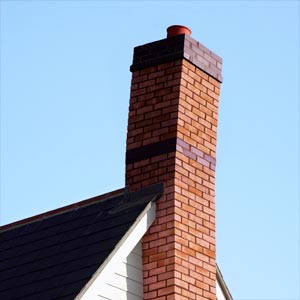
The chimney, an iconic and functional element of many homes, provides warmth and aesthetic charm. However, its exposed position on the roof makes it vulnerable to weather elements, particularly water. One common source of water intrusion is through damaged or improperly installed chimney flashing. Flashing is a critical component that creates a watertight seal between the chimney and the roof, preventing leaks and water damage to the interior of the home. In this comprehensive guide, we delve into the importance of chimney flashing, signs of damage, and step-by-step instructions for repairing chimney flashing to safeguard against water damage.
The Role of Chimney Flashing:
Chimney flashing is a weatherproofing element designed to create a seamless barrier between the chimney structure and the roofing material. It consists of metal strips, typically made of aluminum or galvanized steel, that are strategically placed to prevent water from infiltrating the vulnerable intersection of the chimney and the roof. Properly installed flashing directs water away from the chimney, ensuring that it doesn’t seep into the attic, ceilings, or walls.
The two primary types of chimney flashing are step flashing and continuous flashing. Step flashing is installed in a stair-step pattern along the chimney’s slope, while continuous flashing is a single piece that wraps around the base of the chimney. Both types work in conjunction with counterflashing, which is embedded in the chimney mortar joints, creating a water-resistant barrier.
Signs of Damaged Chimney Flashing:
Detecting early signs of damaged chimney flashing is crucial in preventing extensive water damage to the home. Here are common indicators that your chimney flashing may be compromised:
- Water Stains on Ceilings or Walls:
- Water stains on interior ceilings or walls near the chimney are clear signs of water intrusion. If left unaddressed, these stains can lead to more significant issues like mold growth and structural damage.
- Deterioration of Chimney Mortar:
- Inspect the mortar joints around the chimney. If you notice crumbling or deterioration, it may indicate that water is penetrating through damaged flashing. Over time, this can weaken the chimney structure.
- Visible Gaps or Rust on Flashing:
- Check the flashing for visible gaps, cracks, or rust. Rust on metal flashing indicates corrosion, which compromises its effectiveness. Gaps or cracks allow water to seep through, undermining the purpose of the flashing.
- Loose or Missing Flashing:
- Flashing should be securely attached to both the chimney and the roof. Loose or missing flashing can create entry points for water. Strong winds, storms, or age can contribute to the displacement of flashing.
- Water Pooling Around the Base of the Chimney:
- Examine the roof around the base of the chimney. If you observe water pooling or lingering around the chimney, it suggests that the flashing may not be directing water away as intended.
Repairing Chimney Flashing: Step-by-Step Guide:
Repairing damaged chimney flashing is a task that requires attention to detail and careful execution. Below is a step-by-step guide to help you repair chimney flashing and prevent water damage:
1. Safety Precautions:
- Before starting any repair work, prioritize safety. Use appropriate personal protective equipment, such as gloves and safety glasses. Ensure that the roof is dry and stable before climbing, and exercise caution when working at heights.
2. Gather Materials and Tools:
- Collect the necessary materials and tools for the repair, including replacement flashing, roofing cement or sealant, a pry bar, roofing nails, and a caulking gun. The type of flashing material should match the existing flashing for uniformity.
3. Remove Damaged Flashing:
- Carefully remove the damaged or compromised flashing using a pry bar. Take note of the existing configuration and placement of the flashing, as this will guide the installation of the new flashing.
4. Clean the Area:
- Thoroughly clean the area where the old flashing was removed. Remove any debris, old sealant, or nails. A clean surface ensures proper adhesion for the new flashing and sealant.
5. Install Step Flashing:
- If you are using step flashing, install it in a stair-step pattern along the slope of the chimney. Each piece of step flashing should overlap the previous one, creating a continuous barrier against water intrusion. Secure the step flashing in place with roofing nails.
6. Apply Counterflashing:
- Install counterflashing by embedding it into the chimney mortar joints. The counterflashing should overlap the step flashing, creating a seamless connection. Use a pointing trowel to press the counterflashing into the mortar joints securely.
7. Seal the Joints:
- Apply roofing cement or a high-quality sealant to the joints and seams of the flashing. This additional layer of protection helps create a watertight seal and prevents water from seeping through any gaps. Use a caulking gun for precise application.
8. Inspect and Test:
- Conduct a thorough visual inspection of the repaired flashing. Ensure that there are no visible gaps, and the flashing is securely in place. Test the repair by simulating rain with a hose, observing how water flows around the chimney. Check for any signs of leakage.
9. Address Additional Issues:
- If during the inspection, you discover other issues such as damaged shingles or roofing material, address them promptly. A comprehensive repair approach ensures the overall integrity of the roof and chimney system.
10. Regular Maintenance:
- Implement a routine maintenance schedule for your chimney and flashing. Regular inspections, especially after severe weather events, can help identify and address potential issues before they escalate.
Professional Assistance:
While some homeowners may feel confident in undertaking chimney flashing repairs as a DIY project, it’s essential to recognize when professional assistance is warranted. If the damage is extensive, or if you are uncomfortable working at heights or on a steep roof, seeking the expertise of a roofing professional is advisable. Professionals have the experience, tools, and knowledge to assess the situation accurately and implement effective repairs.
Conclusion:
Repairing chimney flashing is a crucial task in preventing water damage to your home. As a vital component in the battle against the elements, properly installed and well-maintained flashing ensures that your chimney remains both functional and protective. By being vigilant for signs of damage and addressing issues promptly, you can extend the lifespan of your chimney, safeguard the interior of your home, and enjoy the warmth and charm that this timeless architectural feature provides.



